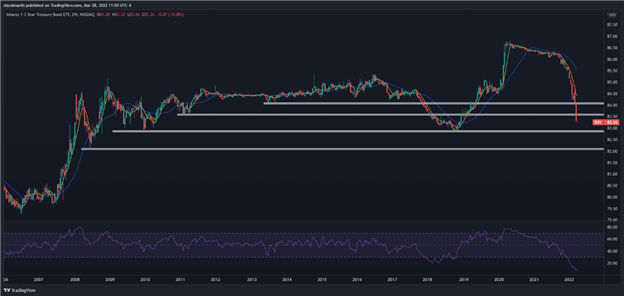US TREASURY YIELDS AND SHY OUTLOOK
- U.S Treasury rates have soared in recent weeks amid hawkish repricing of Fed’s monetary policy outlook
- The short-end of the curve has experienced the largest moves, with the 2-year yield up approximately 88 basis points to 2.32% in March
- With short-dated yields on the rise, SHY will remain on a downward trajectory in the near term
Trade Smarter - Sign up for the DailyFX Newsletter
Receive timely and compelling market commentary from the DailyFX team
Most read: Precious Metals Outlook - Gold Demand Zone Holds Bears at Bay For Now
U.S. Treasury rates have risen aggressively across the curve in March, but the short end has seen the largest increases due to hawkish repricing of the Fed's monetary policy outlook amid blistering inflation. Against this backdrop, the 2-year yield has jumped 88 bps to 2.32%, while the 10-year has popped 63 bps to 2.45% so far this month.
In recent days, several members of the Federal Reserve have added fuel to the fire, reinforcing the surge in yields by calling for borrowing costs to move more quickly from an accommodative to a neutral position and signaling their willingness to hike in 50 basis points increments if necessary.Wall Street has taken the aggressive tightening message in stride, in fact, stocks have rallied significantly since mid-March, so policymakers will have no reason to backtrack or tone down the rhetoric in the near term.
Economic indicators coming out in the next few days could catalyze the next upward leg in rates, especially the latest employment report. Focusing on NFP, the survey, to be released on Friday, is expected to show that the U.S. economy added 490,000 jobs in March and that the unemployment rate fell one tenth of a percent to 3.7%, the lowest level since February 2020. Strong results will bolster the case for removing stimulus forcefully in an effort to restore price stability.



Traders should also keep an eye on average hourly earnings. February's numbers were soft, but wage growth had been strong amid tight labor market conditions, so the trend could resume its upward climb. Although pay increases are good for workers and are helping to offset the purchasing power erosion, an acceleration in earnings may boost inflationary forces, strengthening the argument for front-loading interest rate hikes.
Headline CPI hit 7.9% y/y in February, a four-decade high. This metric was expected to top out in the first quarter, but with much of the passthrough of commodity price pressure from the military conflict in Eastern Europe yet to be felt, inflation will not likely peak until mid-year or even later. This means annual CPI could push above 8% and even flirt with 9% in the coming months, a situation that will prompt more hawkishness from central bankers. As a result,short-dated Treasury rates will remain biased to the upside heading into the next FOMC meeting and the summer.
Foundational Trading Knowledge
Understanding the Stock Market
Recommended by Diego Colman
US TREASURY YIELDS VS SHY
There are many ways to speculate in the Treasury market, but it is important to understand that when yields increase, bond prices fall.
If we believe that short-term government rates will continue to rise on account of aggressive monetary tightening on the horizon, we should expect short-dated Treasury prices to drop (there is an inverse relationship between these two variables as stated before). To position for falling bond prices, traders might consider making a bearish bet on the iShares 1-3 Year Treasury Bond ETF, known as SHY, a fund that seeks to track the investment results of an index composed of U.S. Treasury securities with remaining maturities between one and three years (if yields in the 1–3-year leg of the curve move higher, SHY prices will retreat).
In terms of technical analysis, after breaking below 83.60, SHY has accelerated its decline and is approaching support in the 82.85 area. If sellers manage to drive the ETF below this floor, price could be on its way to challenge the 2008 low near the 82.00 handle. On the flip side, if buyers return and spark a bullish reversal, resistance rests at 83.60, followed by 84.15.
SHY TECHNICAL CHART

SHY Chart Prepared Using TradingView
EDUCATION TOOLS FOR TRADERS
- Are you just interested in the stock market? Download DailyFX quarterly equity forecast
- Would you like to know more about your trading personality? Take the DailyFX quiz and find out
- IG's client positioning data provides valuable information on market sentiment. Get your free guide on how to use this powerful trading indicator here.
---Written by Diego Colman, Contributor





